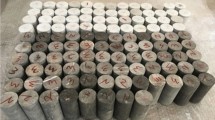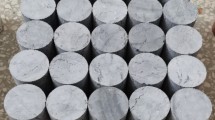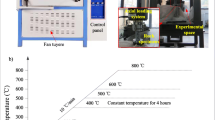Abstract
In the coal mining process, the limestone stratum under coal seams would be affected by high-pressure water, which has a significant influence on its physical and mechanical properties. To study the variation in limestone strength, uniaxial compression tests of three kinds of specimens processed with different water treatment methods are carried out, and the acoustic emission signals are collected during testing to analyze the failure characteristics of the specimens. The results show that the uniaxial compressive strengths of the naturally saturated and forcedly saturated limestone specimens are reduced by 28.01% and 28.27%, respectively, compared to that of the natural limestone specimens. Increasing the water content enhances the plastic deformation properties of this rock. Besides, the failure modes of the limestone specimens change from simple to complex with increasing water content: with increasing water content, it became easier for the specimens to maintain their original shape after failure, which is beneficial to increasing post peak strength.
Article highlights
-
1.
Considering the forcedly saturation state of the limestone under pressure in engineering environment.
-
2.
The acoustic emission is used to analyze the failure process of the limestone specimen during test.
-
3.
Some of the limestone specimen failure modes are different from those predicted by the Mohr-Coulomb strength theory.
-
4.
The water saturation weakening effect of limestone specimen is analyzed from the mechanical properties of water filled cracks and the physical and chemical reactions between the water and minerals in the limestone specimen.














Similar content being viewed by others
Data availability
The data used to support the findings of this study are available upon request.
References
Attewell PB, Farmer IW (1976) Principles of engineering geology. Wiley
Best AI, Sothcott J, Mccann C (2010) A laboratory study of seismic velocity and attenuation anisotropy in near-surface sedimentary rocks. Geophys Prospect 55(5):609–625
Blake W (1982) Microseismic applications for mining—a practical guide. United State Bureau of Mines
Broch E (1974) The influence of water on some rock properties. In: Proceedings of the 3rd congress ISRM, pp 33–38
Cai M, Kaiser PK, Tasaka Y, Maejima T, Morioka H, Minami M (2004) Generalized crack initiation and crack damage stress thresholds of brittle rock masses near underground excavations. Int J Rock Mech Min Sci 41(5):833–847
Colback P, Wiid BL (1965) The influence of moisture content on the compression strength of rocks. In: Proceeding of the 3rd Canadian rock mechanism symposium, pp 65–83
Erguler ZA, Ulusay R (2009) Water-induced variations in mechanical properties of clay-bearing rocks. Int J Rock Mech Min Sci 46(2):355–370
Goodman RE (1963) Subaudible noise during compression of rocks. GSA Bull 74(4):487–490
Goueygou M, Piwakowski B, OuldNaffa S, Buyle-Bodin F (2002) Assessment of broadband ultrasonic attenuation measurements in inhomogeneous media. Ultrasonics 40(1–8):77–82
Hale PA, Shakoor A (2003) A laboratory investigation of the effects of cyclic heating and cooling, wetting and drying, and freezing and thawing on the compression strength of selected sandstones. Environ Eng Geosci 9(2):117–130
Wen H, Dong S, Li Y, Xu J, Wang Q (2015) The influence of cyclic wetting and drying on the fracture toughness of sandstone. Int J Rock Mech Min Sci 78:331–335
Kahraman S, Yeken T (2001) A correlation between P-wave velocity, number of joints and Schmidt hammer rebound number. Int J Rock Mech Min Sci 38(5):729–799
Khanlari G, Abdilor Y (2015) Influence of wet–dry, freeze–thaw, and heat–cool cycles on the physical and mechanical properties of Upper Red sandstones in central Iran. Bull Eng Geol Environ 74(4):1287–1300
Li BY (1999) “Down Three Zones” in the prediction of the water inrush from coalbed floor aquifer theory, development and application. J Shandong Inst Min Technol 18(04):11–18
Li D, Wong L, Liu G, Zhang X (2012) Influence of water content and anisotropy on the strength and deformability of low porosity meta-sedimentary rocks under triaxial compression. Eng Geol 126:46–66
Lockner DA (1993) The role of acoustic emission in the study of rock fracture. Int J Rock Mech Min Sci Geomech Abstr 30(7):883–899
Matsushima J, Suzuki M, Kato Y, Rokugawa S (2015) Ultrasonic measurements of attenuation and velocity of compressional and shear waves in partially frozen unconsolidated sediment and synthetic porous rock. Geophysics 81(2):D141–D153
Padmanabhan E, Sivapriya B, Huang KH, Askury AK, Chow WS (2015) The impact of stylolites and fractures in defining critical petrophysical and geomechanical properties of some carbonate rocks. Geomech Geophys Geo-Energy Geo-Resour 1(1–2):55–67
Pardini G, Guidi GV, Pini R, Regüés D, Gallart F (1996) Structure and porosity of smectitic mudrocks as affected by experimental wetting-drying cycles and freezing-thawing cycles. CATENA 27(3–4):149–165
Peng SS (2006) Longwall mining, 2nd edn. CRC Press, Morgantown
Qian M, Miu XX (1995) Theoretical analysis on the structural form and stability of overlying strata in longwall mining. Chin J Rock Mech Eng 14:97–106
Stagg KG, Zienkiewicz OC (1978) Rock mechanics in engineering practice. Geological Publishing House, Beijing
Sumner PD, Loubser MJ (2008) Experimental sandstone weathering using different wetting and drying moisture amplitudes. J Br Geomorphol Res Group 33(6):985–990
Tao M, Ma A, Cao WZ, Li XB, Gong FQ (2017) Dynamic response of pre-stressed rock with a circular cavity subject to transient loading. Int J Rock Mech Min Sci 99:1–8
Wang B, Li XB (2012) Mesomechanics analysis of static compressive strength and dynamic compressive strength of water-saturated rock under uniaxial load. Explos Shock Waves 32(04):423–431
Wang S, Li HM, Wang W, Li DY (2018a) Experimental study on mechanical behavior and energy dissipation of anthracite coal in natural and forced water-saturation states under triaxial loading. Arab J Geosci 11(21):668
Wang T, Xu DP, Elsworth D, Zhou WB (2016) Distinct element modeling of strength variation in jointed rock masses under uniaxial compression. Geomech Geophys Geo-Energy Geo-Resour 2(1):11–24
Wang W, Li HM, Gu HL (2017) Experimental study of strength characteristics of water-saturated coal specimens under 3d coupled static-dynamic loadings. Chin J Rock Mech Eng 36(10):2406–2414
Wang W, Li HM, Gu HL, Wang C (2015) Feature analysis of energy dissipation of water-saturated coal samples under coupled static-dynamic loads. Chin J Rock Mech Eng 34(S2):3965–3971
Wang W, Wang H, Li DY, Li HM, Liu ZM (2018b) Strength and failure characteristics of natural and water-saturated coal specimens under static and dynamic loads. Shock Vib 2018(PT.4):1–15
Wang W, Zhang S, Li H, Gong S, Liu Z (2019) Analysis of the dynamic impact mechanical characteristics of prestressed saturated fractured coal and rock. Adv. Civ. Eng. 2019(PT.1):5125923.1-5125923.10
Wasantha P, Ranjith PG, Zhang QB, Xu T (2015) Do joint geometrical properties influence the fracturing behaviour of jointed rock? An investigation through joint orientation. Geomech Geophys Geo-Energy Geo-Resour 1(1–2):3–14
Wu XZ, Liu JW, Liu HX, Liu XX (2013) Experimental study on spectrum characteristic of ae during brittle rock fracture under uniaxial compression based on welch. Adv Mater Res 734–737:751–754
Yang Y, Yang J, Sun Y, Zhang D (2015) Numerical study of the stress field during crack growth in porous rocks. Geomech Geophys Geo-Energy Geo-Resour 1(3–4):91–101
Yang Z, Dou L, Chang L, Xu M, Zhen L, Yao Y (2016) Application of high-pressure water jet technology and the theory of rock burst control in roadway. Int J Min Sci Technol 26(005):929–935
Yuan R, Li Y, Jiao Z (2015) Movement of overburden stratum and damage evolution of floor stratum during coal mining above aquifers. Procedia Eng 102:1857–1866
Zhang N, Sheng Z, Li X, Li S, He J (2011) Study of relationship between Poisson’s ratio and angle of internal friction for rocks. Chin J Rock Mech Eng 30:2599–2609
Zhao CL (2001) Sedimentary petrology. Petroleum Industry Press
Zhao XD, Li YH, Yuan RF, Yang TH, Zhang JY, Liu JB (2007) Study on crack dynamic propagation process of rock samples based on acoustic emission location. Chin J Rock Mech Eng 26(05):944–950
Zhao Y, Liu S, Jiang Y, Wang K, Huang Y (2016) Dynamic tensile strength of coal under dry and saturated conditions. Rock Mech Rock Eng 49(5):1709–1720
Zhou ZL, Cai X, Zhao Y, Chen L, Xiong C, Li XB (2016) Strength characteristics of dry and saturated rock at different strain rates. Trans Nonferrous Met Soc China 26(7):1919–1925
Acknowledgements
This paper is financially supported by the National Natural Science Foundation of China (51604093), China Postdoctoral Science Foundation (2020M672227), National Key R&D Program of China (2018YFC0604502), Scientific and Technological Key Project of Henan province (172107000016), Doctoral Research Fund Project of Henan Polytechnic University, China (B2017-42), and the Fundamental Research Funds for the Universities of Henan Province (NSFRF210101).
Author information
Authors and Affiliations
Corresponding author
Additional information
Publisher's Note
Springer Nature remains neutral with regard to jurisdictional claims in published maps and institutional affiliations.
Rights and permissions
About this article
Cite this article
Wen, W., Shiwei, Z., Shen, W. et al. Mechanical behavior of limestone in natural and forced saturation states under uniaxial loading: an experimental study. Geomech. Geophys. Geo-energ. Geo-resour. 7, 65 (2021). https://doi.org/10.1007/s40948-021-00261-6
Received:
Accepted:
Published:
DOI: https://doi.org/10.1007/s40948-021-00261-6




